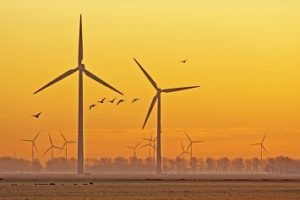We hear a lot of heartbreaking stories about birds being killed by wind turbines. But it’s not just the birds. Wind turbine technician (windtech) is the fastest-growing job in the United States. However, it is certainly not without its hazards. Yesterday we discussed fall and fire hazards windtechs face. Today we will consider other hazards wind energy workers are exposed to and a couple of case studies where events on the turbine took a tragic turn.
Other Hazards for Wind Energy Workers
Confined spaces. Workers who are employed in the manufacture of wind energy equipment are most at risk for hazards associated with confined spaces.
LOTO. Wind turbines have lots of internal machinery and equipment, including blades that need to be maintained. Workers performing servicing or maintenance may be exposed to injuries from the unexpected energization, start-up of the machinery or equipment, or release of stored energy in the equipment. Wind farm employers must implement lockout/tagout (LOTO) procedures outlined in Occupational Safety and Health Administration (OSHA) standards. OSHA provides a letter of interpretation specific to LOTO procedures on wind turbines.
Medical and first aid. Wind farms are normally located in remote locations. Wind energy employers should determine the estimates of emergency medical service response times for all their wind farm locations for all times of the day and night at which they have workers on duty. Employers must ensure that medical personnel are available for advice and consultation and that someone who is trained is available to provide first aid. Trained first-aid providers must be available at all wind farms of any size if there is no nearby clinic or a hospital.
Cranes, derricks, and hoists. Cranes, derricks, and hoists will be used to move the large, heavy loads during wind turbine installation and maintenance. Fatalities and serious injuries can occur if cranes are not inspected and used properly. Since wind turbines are naturally installed in windy areas, the wind speeds at which it is not safe to continue lifting operations need to be determined. According to OSHA, load charts do not generally take wind speeds into consideration. If the load chart or the operating manual does not have information on wind speeds, the crane manufacturer should be consulted.
Electrical. Workers in wind farms are potentially exposed to a variety of serious hazards, such as arc flashes, electric shock, falls, and thermal burn hazards. Wind farm employers are covered by OSHA’s Electric Power Generation, Transmission, and Distribution standard.
Machine guarding. Workers involved in the manufacture of wind turbines are exposed to hazards of moving parts of the machines if they are not safeguarded properly. In addition, the moving parts associated with the turbine, if not guarded properly, may have the potential to cause severe workplace injuries, such as crushed fingers or hands, amputations, burns, or blindness.
Respiratory protection. Respiratory issues primarily affect workers involved in the manufacture of wind turbines. Manufacturing turbine blades involve operations like buffing and resurfacing, which may expose workers to harmful gases, vapors, and dusts.
Case Studies
There are a number of cases where wind turbine workers were killed or injured on the job. Here are two cases where wind turbine workers were killed on the job. EHS managers at wind farms should consider how these deaths could have been avoided.
In the first case, three workers were removing and replacing a broken bolt in the nacelle (turbine housing) assembly of a wind turbine tower that was approximately 200 feet (ft) above the ground. They were heating the bolt with an oxygen-acetylene torch when a fire started. One worker retreated to the rear of the nacelle, away from the ladder access area. While the two coworkers were able to descend the tower, the worker who retreated fell approximately 200 ft to the ground, struck an electrical transformer box, and was killed.
In another case, a worker was working in the bottom power cabinet of a wind turbine. He was checking the electrical connections and came into contact with a bus bar and an arc flash erupted, causing injury. He was taken to a hospital by the technician and was met by the ambulance on the way. He was treated at two different hospitals. Less than a month later, he died.

